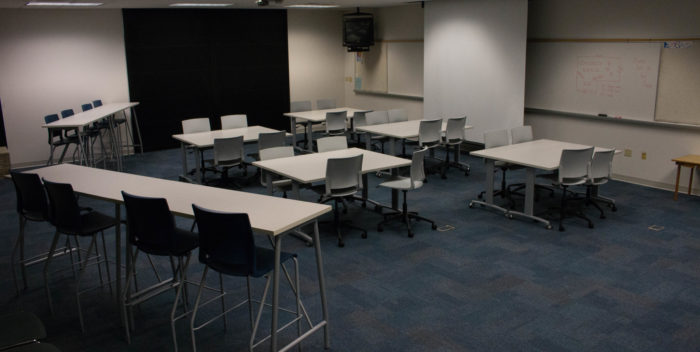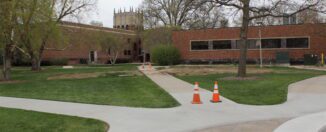Two Thom Classrooms Redesigned as Innovative Learning Spaces
Thom 101 received new furniture to allow for flexibility in classroom arrangements for classes held in that room.
Photo by Kim Sleeper
By Morgan Consier
Over the summer, students often work on projects they don’t have time for during the school year. The same goes for Concordia’s faculty and staff as they work to improve the campus’s buildings and grounds in preparation for the fall semester and the students it brings back to campus.
In addition to the continuing construction of the Dunklau Center for Science, Math and Business, rooms 101 and 104 in the Thom Leadership Education Center have received updates.
Thom 101
In keeping with its original purpose of being used as an educational methods classroom, Thom 101 was renovated over the summer to include updated furniture and technology that will help education students be better prepared for their future classrooms.
“The classroom is redesigned to be three separate learning spaces, so one is a smaller space on the wall closest to the entrance, and then the larger learning space,” Dr. Lorinda Sankey, head of teacher education, said. “The furniture is all on wheels, so it’s all mobile, (and) there’s a potential for a third learning space in the back of the room on the tile.”
The updated technology in the classroom will be available for both students and professors to use. Two screens on opposite sides of the room allow for the possibility of being synced and projecting the same content or being used separately.
“A classroom in (a) school would have different learning areas or study areas. The goal is to replicate that so our students can have their education methods courses in classrooms with those furnishings and settings, so they can learn how to use multiple seating arrangements and technology,” Sankey said.
Sankey noted that the redesign of the classroom was part of a capital funding request which utilized funds for the improvement of the university’s buildings and grounds. The request was written by Assistant Professor of Education and Elementary Education Director Shanna Opfer and was then sent to the Innovative Spaces Committee to be finalized before being taken to university administration for approval.
“The request included a detailed description of the vision for the learning environment, reasons why the new learning space was a necessary improvement for the education program, and a cost breakdown on the requested furniture and technology,” Opfer said.
Before writing the proposal for the project, Opfer visited other universities to see and experience learning spaces that already had this type of furniture and technology in place.
“(T)he design of this classroom came together quickly and easily, as we were able to implement many of the innovative principles seen on those previous campus visits,” Opfer said.
Sankey hopes that other students and classes outside of the education program will be able to use this classroom because of its innovative design in both the technology and the flexibility of the furniture and learning spaces.
“It’s going to take a while for professors to learn how to use that classroom, and they’ll all use it in different ways, I’m sure, but we’re all looking forward to it being used,” Sankey said.
Thom 104
Continuing last summer’s renovations, Thom 104 received updated technology just like its neighbor across the hall, Thom 101. The room received four Sharp 16-inch professional display monitors which are capable of wireless projection.
“We are using a device on them called Airtame that allows for wireless projection, so the instructor will not be tethered to a cable to plug into the system,” Instructional Innovation Specialist Peter Landrey said.
Students as well as professors can connect to this device through an app that is available on their phones or laptops. From their laptops, they will be able to project anything that is on their desktop but are limited to still images and documents on mobile devices.
Like Thom 101, the installation of multiple screens combined with the movable furniture allows students to watch a presentation from wherever they happen to be in the room.
“The concept of having them all around is that when you’re sitting in a group or whatever, you don’t have to look to where the project is, you just have to look up and they’re right there,” Landrey said.
Since the screens can be used independently of one another, education students will also be able to use them for small group work in their classes as they prepare for their own future classrooms.













